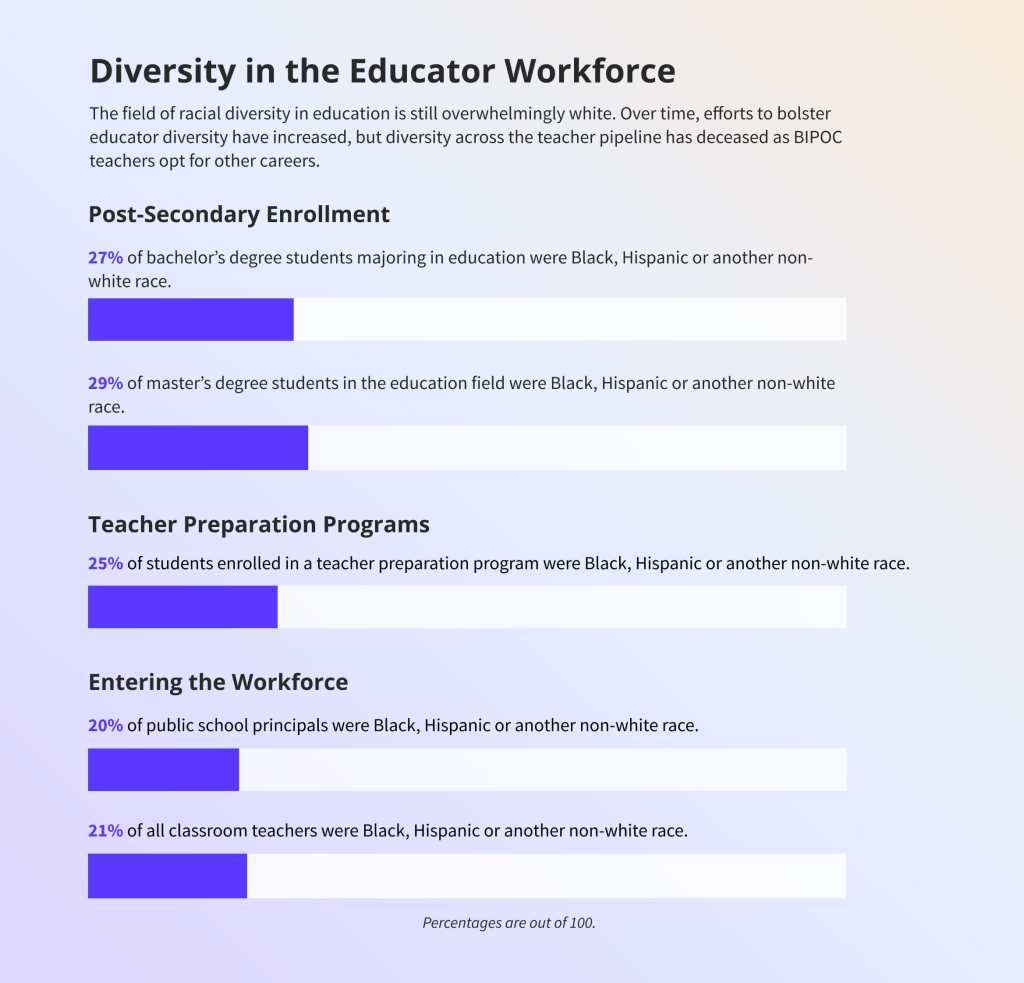How to Support Teachers of Color

When former educator Arielle Miller started teaching at a new school, one of the first things the principal told her was, “We’d love for you to run the Black Student Achievement Program.”
As a Black woman, Miller wanted to advocate for students of color—it was part of why she became a teacher in the first place. However, she also felt boxed in, as if the school’s collective responsibility of attending to minority students weighed entirely on her shoulders. For example, other teachers often transferred certain students to her classroom, justifying the transfer by saying Miller had a proven track record of success with “difficult” students.
“I’ve driven students home because they don’t have anyone else. I show up to their games. I’m always there for them, but I wonder if other teachers took that time to know why a student is acting up and ask what’s really going on,” said Miller, who taught math for eight years while working in a diverse range of schools, from Dubai to Howard County, Maryland.
“I look at [my students] and see that this is a cry for something deeper than just education,” she said. “But it takes time to build that relationship and establish respect, which takes time away from instruction.”
Miller’s experience reflects what many BIPOC (Black, Indigenous, and people of color) teachers face on a daily basis: the pressure to take on additional, unpaid responsibilities rooted in emotional labor and diversity expertise. This is often referred to as an “invisible tax.” Like Miller, who changed careers, many BIPOC teachers are leaving the profession quickly due to burnout.
Teachers of color are crucial members of the education system. It’s important to provide ongoing support for them at every stage of their careers so they can continue making positive impacts on students and advancing inclusive representation.
What Does Diversity Look Like in Education?
Education in America is predominantly white. Teachers, school administrators, principals and aspiring educators at the elementary and secondary levels are all racially homogenous groups, according to a 2016 report on racial diversity in schools from the U.S. Department of Education (PDF, 1.2MB). Moreover, racial diversity tends to decrease at each stage in the pipeline.

Go to a tabular version of the data in the graphic “Diversity in the Educator Workforce”.
Students pursuing a bachelor’s degree in education—the main entry into the teaching profession—are also overwhelmingly white, according to Digital Promise’s Pipeline and Retention of Teachers of Color report (PDF, 242KB). Additionally, students with significant debt from college loans are less likely to choose teaching or other low-paying professions.
Teachers of color often experience financial burden when entering the profession. Many BIPOC teachers come from families who do not have the financial means to make up for low teacher salaries, according to a TeachPlus report about why teachers of color leave the profession (PDF, 12.2MB). Some BIPOC teachers are still expected to help financially provide for their families of origin, which can also drive high turnover rates.
Roughly 19% of teachers of color either move schools or leave the profession annually (PDF, 460 KB), the Learning Policy Institute reported.
BIPOC teachers are leaving the profession more quickly than their white peers. Some choose to leave because they feel they are being pigeonholed into roles due to race, such as acting as a disciplinarian or counselor. Teachers of color often feel pressure to represent the needs of students of color while their ideas of innovating curriculum can sometimes be dismissed. They may also be evaluated more harshly than white teachers, causing them to feel undervalued and unappreciated.
Teacher Retention
Percentage of teachers who left their school after one year between the 2011-12 and 2012-13 school years, according to the U.S. Department of Education report:
22%
of Black teachers
22%
of Hispanic teachers
15%
of white teachers
According to the Learning Policy Institute report, other challenges that drive high turnover rates include:
- Inadequate teacher preparation. Teachers with the least comprehensive teacher preparation are more likely to leave their teaching position or teaching altogether than more prepared candidates.
- Poor working conditions. Many teachers of color go to low-income or high poverty areas with challenging conditions such as lack of administrative support, poor accountability measures and discriminatory behavior.
- School closures. School closings and layoffs across cities led to a disproportionately higher rate of involuntary turnover for Black teachers, who kept moving schools.
- Lack of support. There’s a higher expectation that BIPOC teachers will be there for minority students, creating a disconnect because other teachers may not feel the same responsibility to be present for those students.
As one of the few Black teachers in her previous school, Miller was open and receptive to students and teachers leaning on her for advice on Black issues. At the same time, it was hard for her to be the main person carrying the emotional labor because she felt other teachers were not as involved in sharing that responsibility.
“It furthered the divide because Black teachers did Black things, and the other teachers were able to wash their hands of anything of that nature,” Miller said.
How Do Teachers of Color Make a Difference?
BIPOC teachers positively impact students in ways that benefit them long after they leave the classroom. According to the Learning Policy Institute’s report on diversity in the teaching profession, here are some of the benefits of having teachers of color:

Improving learning for all students. Students of color and white students alike reported that having teachers of color made them feel cared for and academically challenged.

Closing achievement gaps for students of color. Students of color reportedly have higher test scores, higher graduation rates and higher college enrollment rates when they are taught by teachers of color.

Serving as role models. Students of color can see teachers with a similar racial or cultural background and feel solidarity. BIPOC teachers may also be less likely to hold implicit biases.

Adding more diversity to schools. Having more teachers of color can help mitigate feelings of isolation, frustration and fatigue that other teachers of color experience—feelings that might otherwise lead them to leave the profession.

Advocating for students of color. Teachers of color can explain cultural language perceived as offensive or disrespectful to other educators.
“Students do feel less pressure talking to me,” Miller said. “They look at me and see a sister, an aunt or a mom. I can see these kids are going through hard stuff just to sit here every day, and I don’t know if they would have been comfortable to share that with anyone else.”
According to a Brookings Institution report on teacher diversity, the way Black male students perceived their teacher’s ability to control the classroom shifted when they had a teacher who looked like them. Those students also described how orderly and productive the classroom felt while teachers wasted less time disciplining students.
Representation in education matters. For many students of color, seeing BIPOC teachers can help them realistically consider different professions and open their minds.
“When I was in school, my guidance counselors saw my math skills and told me to become a math teacher. But why didn’t anyone tell me I could have been a statistician or an engineer? I would have loved to work for NASA,” Miller said.
“I wanted to open my students’ minds so they could see themselves in different professions other than athletes, entertainers, or store and gig workers. They see themselves in me—like if she could be a teacher, then I could be one one day, too.”
What Are Ways to Support Teachers of Color?
School staff, parents of students, education leaders and other teachers can make a difference at their schools by supporting teachers of color. Miller eventually left the teaching profession due to a combination of lack of pay, respect and parental and administrative support. She offers up these suggestions to support BIPOC teachers:
1
Share responsibility evenly with other teachers. Miller said teachers of color often spend extra time coming up with strategies and culturally relevant practices. It’s important to hire dedicated experts who can help with that so it doesn’t detract from teaching.
2
Increase diversity among teachers. School boards can hire more diverse teachers in different demographics, including teachers who identify as LGBTQ, neurodivergent individuals, or other minorities. Miller said this would help build more trust in the education system.
3
Focus on teacher recruitment. School boards should hire more teachers of color from historically Black colleges and universities (HBCUs). They should also make a concentrated effort to make teachers of color feel welcome and included at school.
4
Partner with HBCUs and community organizations. There are many nonprofits in the space of race, culture and identity that can help create a more inclusive and supportive environment at schools.
5
Hire earlier in the year. This is because more in-demand candidates of color may be available at this time. It’s important to give teachers of color the best chances to be hired.
6
Support their first year of teaching. Schools can do this by matching first-year teachers of color with mentor teachers or providing additional classroom assistance and collaboration. Making BIPOC teachers feel like their contributions are valued and listened to can boost morale.
Supporting teachers can be similar to the way teachers already know how to support students. They can build empowering environments by acknowledging others’ needs and creating safe spaces to express them. When Miller was a teacher, she pasted a rainbow-colored “Safe Space” decal on her classroom door.
“The students [who] see this know what it means. The ones who are meant to notice it feel safe here. Even if students weren’t fine, they could walk by and smile or wink, just nod like, ‘You see me.’ That’s the way I want teachers of color to feel. It’s a mindset and cultural shift,” Miller said.
Additional Resources for Teachers of Color
- Center for Racial Equity in Education (CREED): an organization dedicated to changing educational experiences of racial minorities and fighting systemic racism in education.
- National Alliance of Black School Educators (NABSE): an organization advancing the academic success of Black students.
- Teachers of Color Foundation: an organization focused on recruiting, educating and retaining teachers of color that provides scholarships, mentoring, race and equity training and professional development.
- National Association for Multicultural Education (NAME): an organization advocating for multicultural education, equity and social justice.
- Educators of Color Affinity/Resource Group: an online community for educators dedicated to exploring how race impacts teachers of color in work and increasing diversity leadership through stories, resources and shared experiences.
- EduColor: an organization advocating for education equity nationwide and support networks for educators of color.
Diversity in the Educator Workforce
The following section contains tabular data from the graphics in this post.
| Category | Group | Percent of group that is a non-white race |
|---|---|---|
Post-Secondary Enrollment | bachelor’s degree students majoring in education | 27 |
Post-Secondary Enrollment | master’s degree students in the education field | 29 |
Teacher Preparation Programs | enrolled in teacher prep program | 25 |
Entering the Workforce | public school principals | 20 |
Entering the Workforce | classroom teachers | 21 |
